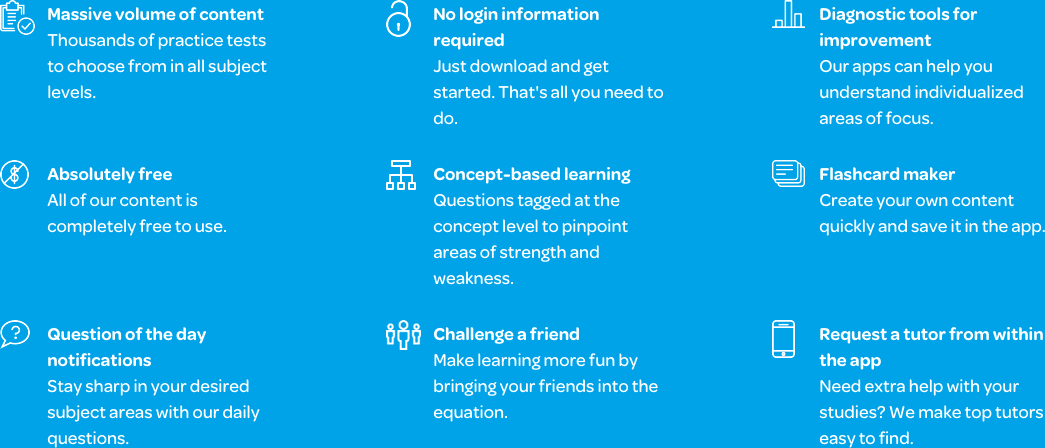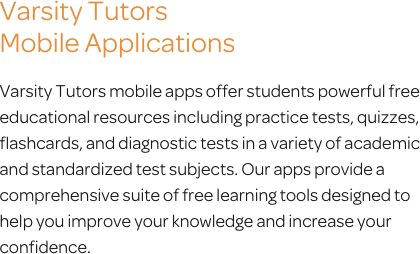The Varsity Tutors Basic Geometry Mobile App
Basic geometry can be a difficult course to master. You may need additional help to learn midpoints, angles, planes, and other concepts within the subject. With the Varsity Tutors Geometry app, available from iTunes and the Google Play Store for both Android and Apple devices, many students are able to improve their understanding in a simple, convenient manner. The app offers flexible content that can help you to review the basics or gain a deeper comprehension of a particular concept. Through these resources, you can begin to piece together a study plan that works best for your needs.
Through the learning tool, you are able to explore geometric principles, take full-length practice tests, and more. You can access hundreds of materials on each base concept to provide individualized instruction in the areas in which you need more help. Rather than going through all of the concepts, you can choose to remove the concepts that you understand well to avoid spending your precious study time on needless work.
All the content available on the app is written by a professional with a full understanding of geometry. Using the material, it is possible to gain deeper knowledge on concepts such as plane geometry, where you may find problems that require you to find the length of a diameter, the angle of a line, or point out the differences between types of triangles. There is a great deal of material on the Pythagorean Theorem, congruency, shapes, and many other topics.
You can use the test results to identify concepts that you need to study further, allowing you to enhance your study period’s overall efficiency. Through timed practice tests, you can learn a great deal of information about the topics on which you need to focus. The basic geometry practice tests are arranged by concept, ensuring that you can take tests that focus solely on the concept you are having trouble with. With each test question, you are given a detailed explanation that allows you to fully understand where you may have gone wrong, and how to solve the problem correctly next time.
The app also gives you access to a plethora of flashcards that you can use for fast-paced studying. In addition, you can form your own using the Flashcard Maker. Flashcards can be a great way to study with classmates or family members. You simply choose the concept you want to study, review the question, and do your best to solve it. Upon answering, you receive a full explanation of the problem at hand and the concepts that relate to solving it.
Along with practice tests and flashcards, you will also have access to the basic geometry Learn by Concept feature. This tool breaks a full basic geometry course down into the key concepts and strategies needed for the class. You can use these to go over equations, vocabulary, and other topics to refresh your memory before taking one of the full-length practice tests. Each exam is timed and designed to mimic a real exam as much as possible, so you can get the practice needed for the real exam without any stress.
The Varsity Tutors Geometry app is a versatile tool that you may be able to take advantage of to improve your comprehension in math. The app is available on the Google Play Store and iTunes.
66 mobile apps to choose from for your tutoring needs.

Learn More
If you are a high school student who is working towards a college preparatory diploma, or if you are preparing for a vocational skill that requires an advanced proficiency in mathematics, you will likely need to complete a geometry course. While you have probably covered some basic geometry knowledge in middle school, where you touched on how to calculate area, diameter, and circumference, things get a bit more challenging in high school geometry.
In this course, you will be required to learn about graphing lines, planes, and various shapes. Geometry is more than just drawing on a grid, though. You also learn how to measure, scale, conceptualize infinites, and perform additional operations on two- and three-dimensional lines and shapes. By completing this course, you will have gained knowledge of concepts that are important for tackling trigonometry.
It’s likely the first topic you’ll cover is coordinate geometry, which involves learning the basics of graphing. Here, you will learn how to find the distance between midpoints, solve problems on a coordinate plane, and learn about the different parts on a graph. You will also learn about the properties of a grid, the Cartesian plane, and how points are plotted on the x and y axis.
As you familiarize yourself with graphs, you will need to develop a deeper understanding of line segments and rays. You should know that rays are lines that start at a point and continue forever in a direction, whereas line segments have a starting and stopping point. You need to also be familiar with the following types of angles: vertical, corresponding, alternate interior, alternate exterior, and consecutive interior.
The midpoint theorem is an important concept in geometry related to line segments. Because line segments are not infinite, like rays, they have a midpoint. This theorem states that, by calculating the midpoint, you are able to find the beginning and the end of the line. This is because the middle is actually the average of both point coordinates.
Because shapes are an important part of geometry, planar geometry will be your next major focus. You start by expanding upon your knowledge of triangles and rectangles. For example, you’ll find out how to calculate the area of these shapes, and you also learn how to find their perimeters. While these formulas seem basic, you will need them to assist you in more difficult problems you encounter later on.
Not all triangles are created equally. You need to know the different types of triangles, and be able to explain the differences between them. For example, you should note that isosceles triangles have two equal angles, whereas a scalene triangle shares no equal sides. Moreover, you should also be familiar with interior and exterior angles of a triangle, and how to solve for an unknown variable. Understanding polygons is also an important part of mastering geometry. You should learn that a polygon is a two-dimensional shape that is formed with straight lines, and it can have a various number of sides.
You will also learn how to work with circles, another important component of a geometry course. You will learn the required formula to find the area of a circle. Additionally, you will be taught that the circumference measures how much space a circle is taking up, as well as the equation for finding the circumference. Moreover, it is important that you remember that, while circles have a circumference, other shapes have a perimeter.
As you become more proficient in geometry, you will begin to explore new concepts, like geometric solids. You will become familiar with planes, and know that they are flat surfaces that stretch infinitely in every direction. You will learn that a polyhedron is a three-dimensional shape made up several flat, connected shapes. In addition, while exploring three-dimensional shapes, you will be introduced to platonic solids, and you get familiar with the five types of this shape: the tetrahedron, cube, octahedron, dodecahedron, and icosahedron.
The more adept you become in geometry, the more experience you will gain working with complex shapes like prisms, pyramids, cylinders, and cones. You will learn about spheres, which are how three-dimensional circular shapes are conceptualized. You will work to gain the skill of finding the surface area of spheres, as well as the measurements of the other aforementioned shapes. All of these shapes have a component that two-dimensional shapes lack: depth.
Another important aspect of a geometry course is developing an understanding of inductive and deductive reasoning, and how they relate to geometry. You should learn about how deductive reasoning is the process where a point is made through reaching a series of conclusions. Inductive reasoning, on the other hand, is to reach a conclusion through observations. Because deductive reasoning allows us to reach a conclusion based on known facts, rather than observation, we can incorporate our prior knowledge of geometry into our solution. Thus, deductive reasoning is used much more frequently in geometry.
Along with deductive reasoning, another important concept that you will become familiar with is “Euclid’s Postulates.” Euclid was a famous Greek mathematician who laid the groundwork for geometry, which he introduced in a book called “Elements.” This book contained the five basic truths in geometry, like how a line segment can extend infinitely in two directions, or how all right angles are equal to each other. These facts are an important part of geometry, and you could likely be tested on it in the future.
While geometry is a comprehensive subject that can be overwhelming to some, it is an important part of a number of professions. If you are interested in pursuing a career in engineering, architecture, and construction, you will need to have a working knowledge of geometry. Moreover, if you plan on pursuing a career in medicine, you will also need to understand elements within geometry, and how they relate to body weight and medicine dosage. Even though school curriculum varies between institutions, the material mentioned here is commonly covered throughout geometry lessons. By studying this material, you are working to prepare yourself for success in a geometry course.




